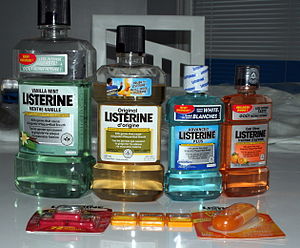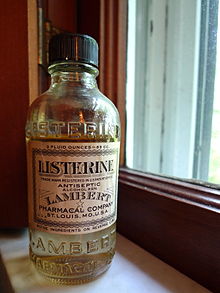
Listerine
USINFO | 2014-02-13 16:42

Listerine is a brand of antiseptic mouthwash product. Currently promoted with the slogan "Kills germs that cause bad breath", it was named afterJoseph Lister who advocated the idea of sterile surgery by sterilizing instruments.
Originally marketed by the Lambert Pharmacal Company (which later became Warner-Lambert), it is currently manufactured and distributed by Johnson & Johnson since that company's acquisition of Pfizer's consumer healthcare division in late December 2006.
The Listerine brand name is also used on toothpaste, Listerine Whitening rinse, Listerine Fluoride rinse (Listerine Tooth Defense), Listerine SmartRinse (children's fluoride rinse), PocketPaks, and PocketMist. In September 2007, Listerine began selling their own brand of self-dissolving teeth whitening strips.
History

Glass bottle with paper label. The screw top indicates that the bottle was manufactured post-1920s.
First formulated by Dr. Joseph Lawrence and Jordan Wheat Lambert in St. Louis, Missouri, in 1879 as surgical antiseptic, it was given to dentists for oral care in 1895 and it was the first over-the-counter mouthwash sold in the United States, in 1914.
In 1885, Lawrence sold his share to the Lambert Pharmacal Company.
According to Freakonomics:
Listerine, for instance, was invented in the nineteenth century as powerful surgical antiseptic. It was later sold, in distilled form, as both a floor cleaner and a cure for gonorrhea. But it wasn't a runaway success until the 1920s, when it was pitched as a solution for "chronic halitosis"— a then obscure medical term for bad breath. Listerine's new ads featured forlorn young women and men, eager for marriage but turned off by their mate's rotten breath. "Can I be happy with him in spite of that?" one maiden asked herself. Until that time, bad breath was not conventionally considered such a catastrophe. But Listerine changed that. As the advertising scholar James B. Twitchell writes, "Listerine did not make mouthwash as much as it made halitosis." In just seven years, the company's revenues rose from $115,000 to more than $8 million.
In this way, Listerine became a clear and early example of a larger trend: marketing campaigns inventing problems that the product is alleged to solve.
In 1955, Lambert Pharmacal merged with New York-based Warner-Hudnut and became Warner-Lambert Pharmaceutical Company and incorporated in Delaware with its corporate headquarters in Morris, New Jersey. In 2000 Pfizer acquired Warner-Lambert. Among Lambert's assets was the original land for Lambert-St. Louis International Airport.
From 1921 until the mid-1970s, Listerine was also marketed as preventive and remedy for colds and sore throats. In 1976, the Federal Trade Commission ruled that these claims were misleading, and that Listerine had "no efficacy" at either preventing or alleviating the symptoms of sore throats and colds. Warner-Lambert was ordered to stop making the claims, and to include in the next 10.2 million dollars' worth of Listerine ads specific mention that "contrary to prior advertising, Listerine will not help prevent colds or sore throats or lessen their severity."
For a short time, beginning in 1927, the Lambert Pharmaceutical Company even marketed Listerine Cigarettes.
1930s advertisements claimed that applying Listerine to the scalp could prevent dandruff.
Listerine was packaged in a glass bottle inside a corrugated cardboard tube for nearly 80 years before the first revamps were made to the brand; in 1992, Cool Mint Listerine was introduced in addition to the original Listerine Antiseptic formula and, in 1994, both brands were introduced in plastic bottles for the first time. That same year, just after switching to plastic, FreshBurst was added, then in 2003 Natural Citrus. In 2006 a new addition to the "less intense" variety, Vanilla Mint, was released. Currently, eight different kinds of Listerine are on the market in the U.S. and elsewhere: Original, Cool Mint, FreshBurst, Natural Citrus, Vanilla Mint, Advanced with Tartar Control (Arctic mint), Tooth Defense (mint shield), and Whitening pre-brush rinse (clean mint). The most recent addition is the Listerine Total Care, marketed as the Most Complete Listerine. It claims to reduce plaque, strengthen teeth to prevent cavities, prevent tartar build-up to keep teeth white, freshen breath for up to 12 hours.
Composition
The active ingredients listed on Listerine bottles are essential oils menthol 0.042%, thymol 0.064%, methyl salicylate 0.06%, and eucalyptol 0.092%. In combination all have an antiseptic effect and there is some thought that methyl salicylate may have an anti inflammatory effect as well[citation needed]. Ethanol, which is toxic to bacteria at concentrations of 40%, is present in concentrations of 21.6% in the flavored product and 26.9% in the original gold Listerine Antiseptic. At this concentration, the ethanol serves to dissolve the active ingredients.
Materials Safety Data Sheet for Listerine Antiseptic Mouthwash, Original-05/22/2008
Effectiveness
Additional rinsing helps in reducing dental plaque and gingivitis in children, in addition to reducing the risk of bleeding from the gingival sulcus. However, the effect of extra rinsing with water is not as beneficial as using Listerine as part of everyday oral hygiene. (The label of the new whitening pre-rinse recommends consumers use one of the other Listerine formulas for fighting plaque).
In a January 6, 2005, decision, Judge Denny Chin of the United States District Court for the Southern District of New York ruled that an advertising campaign by Pfizer, claiming that the mouthwash Listerine is as effective as flossing in fighting tooth and gum decay, is false and misleading and poses a public health risk.
In 2010 a study was published which noted that performing a brief 30 second rinse with Listerine (Vanilla Mint Flavor) prior to applying topical lidocaine to patients mouths masks the unpleasant flavor of topical lidocaine. It is suspected this may help improve the comfort of a variety of oral procedures performed by dentists and oral surgeons.
Safety
There has been concern that the use of alcohol-containing mouthwash such as Listerine may increase the risk of developing oral cancer, a gruelling and mutilating disease. Studies conducted in 1985, 1995, and 2003 summarize that alcohol-containing mouth rinses are not associated with oral cancer. However, a review of a study carried out in Cuba, Argentina, and Brazil published December 2008 in the Australian Dental Journal concluded that:
There is now sufficient evidence to accept the proposition that developing oral cancer is increased or contributed to by the use of alcohol-containing mouthwashes. Whilst many of these products may have been shown to be effective in penetrating oral microbial biofilms in vitro and reducing oral bacterial load, it would be wise to restrict their use to short-term therapeutic situations if needed. Perhaps the use of mouthwashes that do not contain alcohol may be equally effective. Further, mouthrinses should be prescribed by dentists, like any other medication. There may well be a reason for the use of alcohol-containing mouthrinses, but only for a particular situation and for a limited and controlled period of time. As such, patients should be provided with written instructions for mouthwash use, and mouthwash use should be restricted to adults for short durations and specific, clearly defined reasons. It is the opinion of the authors that, in light of the evidence currently available of the association of alcohol-containing mouthwashes with the development of oral cancer, it would be inadvisable for oral healthcare professionals to recommend the long-term use of alcohol-containing mouthwashes.
In January 2009, Andrew Penman, chief executive of The Cancer Council New South Wales, called for further research on the matter.In a March 2009 brief, the American Dental Association said "the available evidence does not support a connection between oral cancer and alcohol-containing mouthrinse".
In 2009, Johnson and Johnson launched a new alcohol-free version of the product called Listerine Zero.
On April 11, 2007, McNeil-PPC disclosed that there were potentially contaminants in all Listerine Agent Cool Blue products sold since its launch in 2006, and that all bottles were being recalled.The recall affects some 4,000,000 bottles sold since that time. According to the company, Listerine Agent Cool Blue is the only product affected by the safety issue and that no other products in the Listerine family were under recall.
Share this page



















